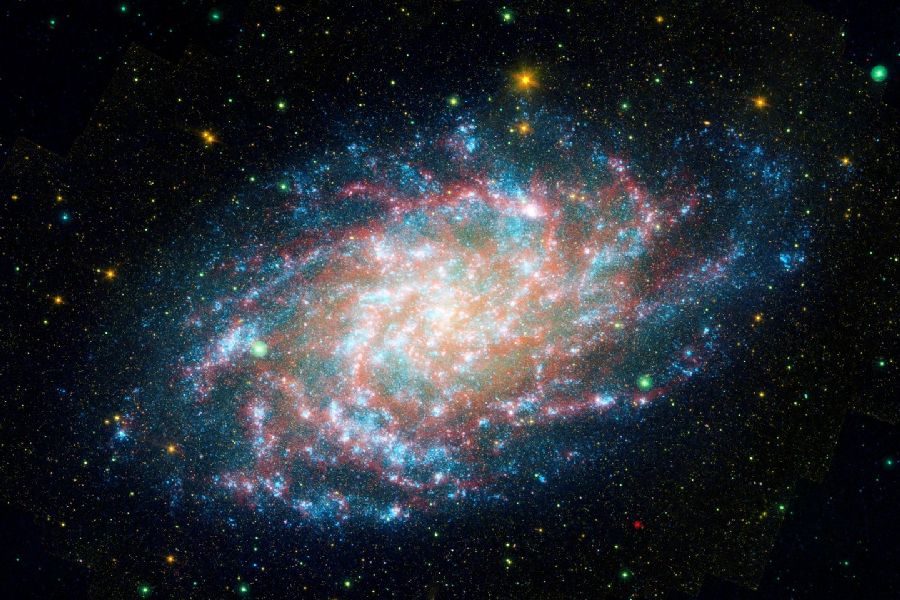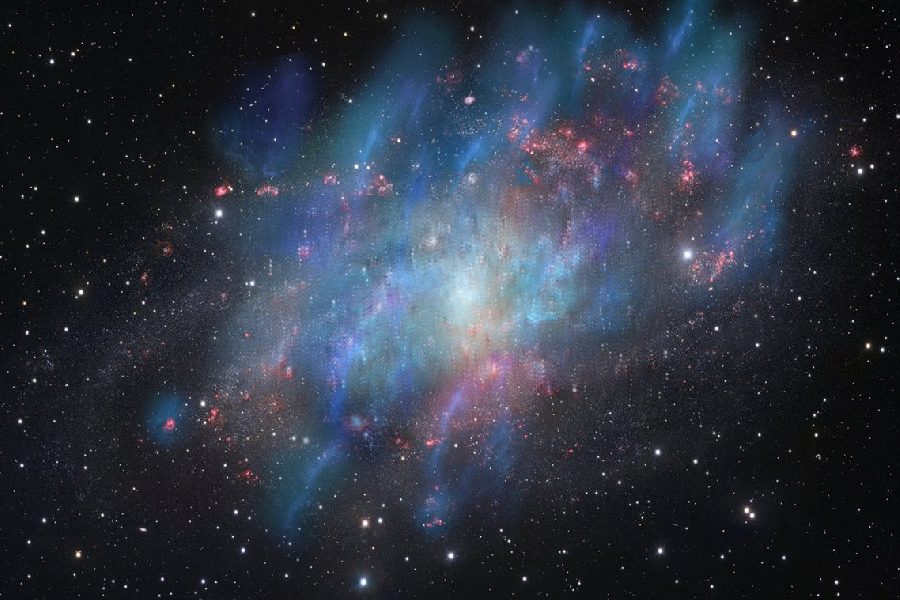Our Milky Way has some intriguing galactic neighbors within our Local Group. One of the most fascinating is the beautiful Triangulum Galaxy, also known as Messier 33. This spiral galaxy reveals tantalizing clues about the nature of our universe through its structure and contents.
In this article, we will explore some of the most fascinating Triangulum Galaxy facts that astronomers have uncovered about this cosmic island.
What secrets does Triangulum hold about stars, nebulae, and the origins of spiral structure? How does Triangulum compare and contrast with our own spiral Milky Way in size, mass, and number of stars?
Let’s dive into some of the most intriguing facts we know to date about the Triangulum Galaxy, one of the closest major galaxies to our own. This article will discover important details about our cosmic neighbor and its structure that shed light on our understanding of the universe.

Triangulum Galaxy Facts
What are some interesting Triangulum Galaxy facts? The Triangulum Galaxy, or Messier 33, graces the constellation Triangulum with its spiral allure. Holding the third-largest position in the Local Group, it shares a destiny with the Andromeda Galaxy in an impending cosmic collision.
This spiral beauty, located some three million light-years away, actively births stars within its prominent arms. Amateur astronomers find it a captivating target in the night sky, enriching our cosmic exploration with its visible and accessible celestial wonders.
Third-largest galaxy in the Local Group with a unique spiral shape
The Triangulum Galaxy is a cosmic marvel when it comes to its size and shape. Delving into these aspects opens a window into the vastness of the universe, inviting exploration into the intricacies of celestial forms.
Scale in the cosmic landscape
Triangulum spans an impressive 60,000 light-years, making it the third-largest galaxy in our Local Group. This colossal scale places it among the cosmic giants.
Contributing to the intricate dance of galaxies in the universe. Exploring its vast dimensions unveils the grandeur of cosmic architecture.
Significance in the galactic context
Emphasizing its size underscores the Triangulum’s importance in the broader context of galaxies. Its distinct shape, characterized by elegant spiral arms, adds to the visual richness of our cosmic neighborhood, making it a celestial gem worthy of exploration.
Studying the galaxy’s form not only reveals its visual allure but also deepens our understanding of galactic structures in the cosmic expanse.
Has a high star formation rate
The Triangulum Galaxy pulsates with life, and understanding its star formation rate unveils the dynamic processes within its celestial expanse. Exploring this rate provides a glimpse into the heartbeat of a galactic entity.
Celestial nurseries
Deep within Triangulum’s vast arms, immense gas clouds collapse, serving as celestial nurseries birthing new stars at a remarkable pace. These cosmic cradles are essential to the galaxy’s vibrant stellar population, fostering the birth of new celestial entities.
Stellar evolution
Triangulum Galaxy has around 40 billion stars in its expanse. The high star formation rate in the Triangulum signifies ongoing processes shaping its stellar landscape. It contributes to the galaxy’s ever-evolving nature, playing a crucial role in the intricate dance of stars and influencing galactic evolution over cosmic timescales.
Unraveling these processes provides insights into the cosmic symphony that defines the Triangulum Galaxy’s existence.
Its brightest object is a luminous blue giant star situated at its core
Within the celestial tapestry of the Triangulum Galaxy, a standout luminary takes center stage – the brightest object which is an entity that holds cosmic significance.
Identifying the luminous focal point
The brightest object in Triangulum is a luminous blue giant star situated at its core, radiating brilliance across the galactic expanse. This stellar beacon distinguishes itself, catching the attention of astronomers and stargazers alike.

Contributing to galactic radiance
Understanding the importance of this luminous entity goes beyond its individual brilliance. It plays a vital role in contributing to the overall radiance of the Triangulum Galaxy. Adding a luminous touch to the cosmic panorama – it shapes the visual identity of this celestial marvel.
Triangulum’s colossal gas clouds impact its composition and birth of stars
The cosmic tapestry of the Triangulum Galaxy is woven with intricate gas clouds, offering insights into the celestial processes that shape its existence.
Nebulous abodes of stellar birth
Within Triangulum’s expansive arms, colossal gas clouds act as celestial nurseries, where gravitational forces trigger the collapse of molecular clouds, giving birth to new stars. These nebulous abodes are crucial in the galaxy’s continual cycle of stellar generation.
Contributions to galactic composition
Examining the presence of gas clouds unveils their role in shaping the Triangulum Galaxy’s overall composition. These cosmic reservoirs play a crucial role in the birth of stars.
Additionally, they have a significant impact on the galaxy’s chemical makeup. This influence enriches the diversity of the Triangulum Galaxy, adding layers to the astronomical narrative. This narrative is painted across its vast expanse.
Harbors a diverse stellar community – Companion stars & giant stars
The Triangulum Galaxy harbors a diverse stellar community, where the presence of companion stars and giant stars adds layers to its celestial narrative.
Celestial partnerships
Companion stars within Triangulum engage in gravitational embraces, forming celestial partnerships that influence the galactic ballet. These gravitational dances shape the stellar dynamics, contributing to the galaxy’s unique charm.
Giant stellar influences
Giant stars, notable for their immense size and luminosity, further enrich the galaxy’s tapestry. Their presence contributes to the diversity of Triangulum’s stellar population, playing a significant role in the cosmic symphony that defines the galactic landscape.
Gets all its splendor from its brightest star and blue stars
In the celestial ensemble of the Triangulum Galaxy, the brightest star and the prevalence of blue stars command attention, each contributing uniquely to the cosmic narrative. This stellar duo adds layers to the galactic tale, enriching the visual and astronomical experience.
Radiant beacon
The brightest star, a stellar beacon at the heart of Triangulum, guides our gaze through its expansive expanse. This luminous entity serves as a focal point, showcasing the galactic radiance and capturing the curiosity of astronomers.
Its brilliance not only illuminates the cosmic stage but also beckons exploration into the mysteries held within.
Blue brilliance
Blue stars, scattered throughout the galaxy, contribute to its luminosity with their intense radiance. Exploring the characteristics of these stars unveils their impact on Triangulum’s overall makeup.
This highlights their role in shaping the visual splendor of this celestial masterpiece. The vibrant hues of blue stars paint a captivating portrait across the cosmic canvas, enhancing the galactic aesthetics.
Conclusion
The Triangulum Galaxy is one of the most intriguing objects in our night sky. Located only three million light-years from Earth, it provides astronomers with ample opportunities to study its structure, contents, and evolution.
Key Triangulum Galaxy facts covered in this article include its spiral shape, its status as the third largest member of the Local Group, and its containing approximately 40 billion stars. While small by cosmic standards, the Triangulum still dazzles as the most distant object visible to the naked eye under dark skies.
Its ethereal glow is a reminder of both the beauty and mystery inherent in our amazing universe. As astronomical research continues, there is still much more left to learn about this not-so-distant neighbor known as the Triangulum Galaxy.
